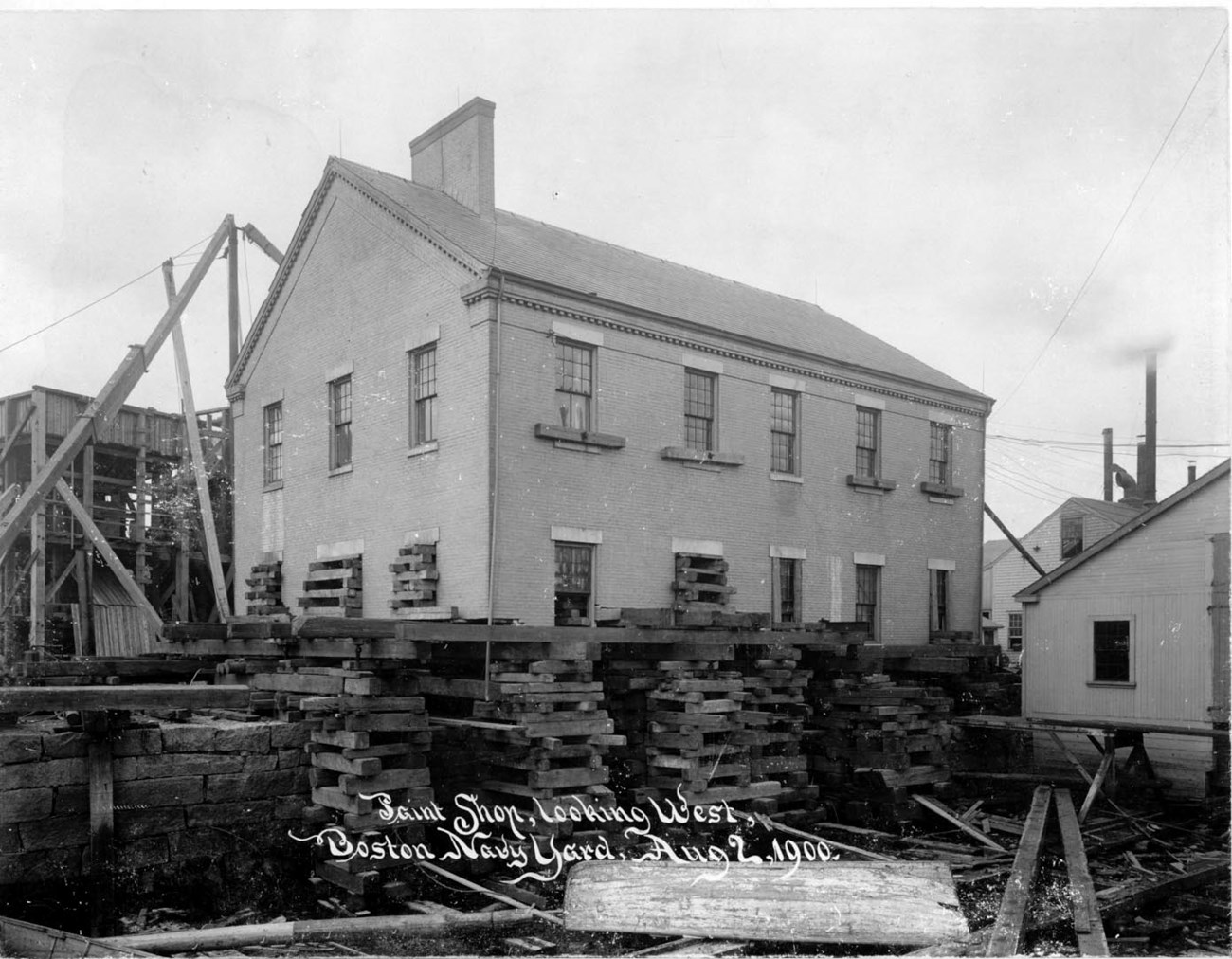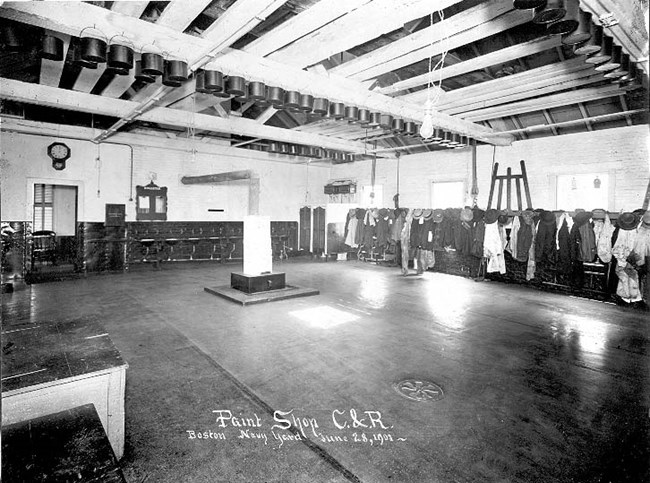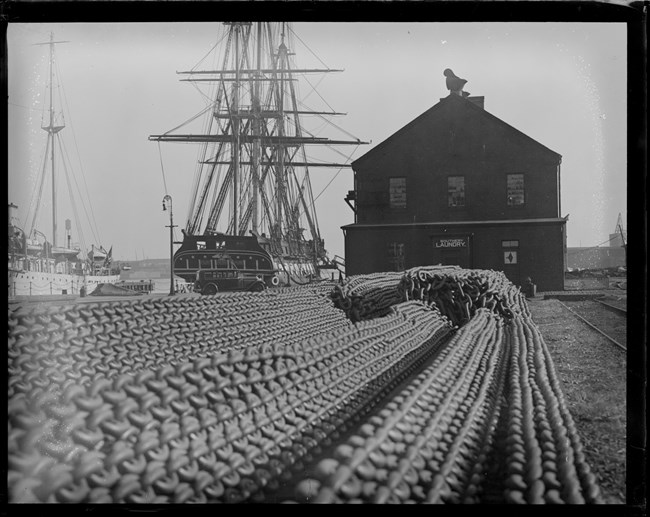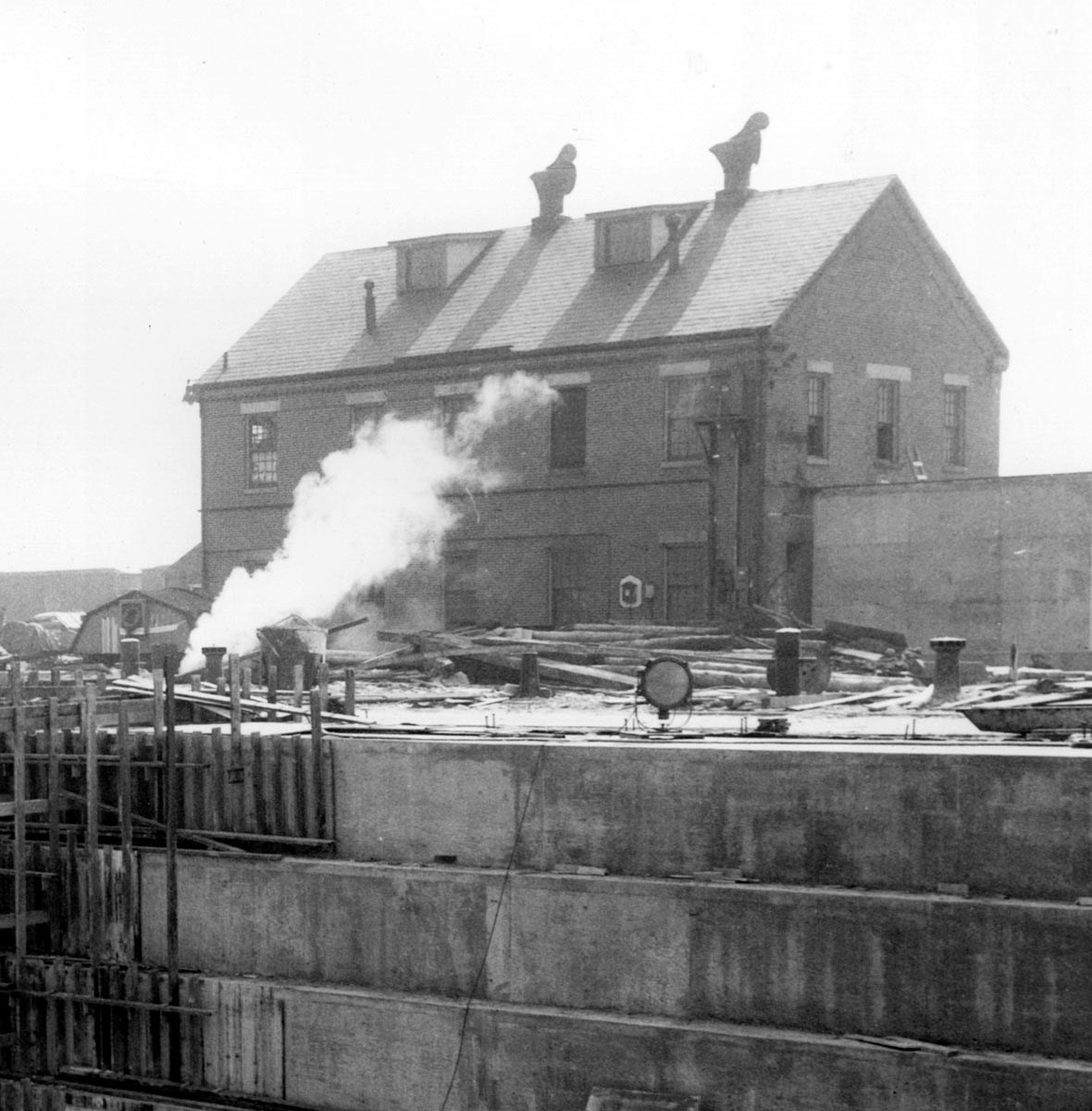Last updated: January 23, 2024
Article
Charlestown Navy Yard: Building 10
Some of the structures at the Charlestown Navy Yard were carefully designed for highly specialized purposes. Buildings such as the ropewalk, for example, even outwardly reflected their purpose through their shape. Building 10, on the other hand, represents a different type of structure at the Navy Yard: one built to fill multiple, evolving roles as the needs of the US Navy constantly changed.

Boston National Historical Park, BOSTS 9270-1.
Oakum Loft and Pitch House
Completed in 1853, Building 10 originally served the yard's caulkers as a pitch house and oakum loft. Caulking—one of the oldest shipbuilding professions—involves the pounding of tarred rope fibers called oakum into the seams of a wooden ship's hull. This critical process made wooden ships like USS Constitution watertight.
Located directly adjacent to Dry Dock 1, Building 10 gave the skilled caulkers easy access to the materials they required when working on ships. This proximity represented the importance the early US Navy placed on caulking.
However, as wooden-hulled ships gave way to iron-hulled vessels in the 1890s, a dedicated building to the craft was no longer needed and the US Navy repurposed Building 10 for the first time.

BNHP, BOSTS 9274-2.
Anti-Fouling Red
Any vessel that spends a significant time in the water will begin to attract certain marine life. Mussels, barnacles, and a whole host of sea grasses can attach themselves to a ship's hull. Eventually, this build-up, called fouling, causes significant drag that both reduces the vessel's top speed and increases fuel consumption.
As a wooden ship, USS Constitution was—and still is—fitted with copper sheeting below its waterline. This inhibits the growth of sea life and aids in keeping the hull clean. Workers used a different method, however, to protect iron-hulled ships. They painted bottoms of these ships with paints containing copper oxide to achieve the same effect against sea life growth. The copper oxide also gives the paint a distinctive red color, and it is still seen on modern ships today.
As painting replaced caulking in the Navy Yard, Building 10's proximity to Dry Dock 1 again made it a convenient place, this time for painters. Before modern mixers, paint sprayers, and other industrial painting tools, painting was a very manual and laborious process. The shop housed materials necessary for hand mixing paints, all the supplies for carrying out and applying the paint to the ships, as well as all the chemicals and materials for cleanup.
Eventually the needs and industrial-scale workload of the paint shop outgrew Building 10. In 1906, Building 10 was again repurposed.
Wireless Station
After a period of use as a storeroom and as office space for different Navy Yard personnel, Building 10 became home to the Yard's second wireless—or, radio—station in 1911. As a structure with large open rooms, Building 10 conveniently housed not only the large radio equipment of the era, but also bunkbeds for radio operators to standby at all hours.
In 1912, the US Navy called upon the radio operators in Building 10 to contact USS Chester, which the Navy dispatched following the Titanic disaster.
Although unsuccessful that night, radio operators in the Navy Yard played an increasingly vital role in search and rescue operations in the New England area. Their needs eventually outgrew Building 10's facilities, however, and the radio station moved in 1915.

Courtesy of the Boston Public Library, Leslie Jones Collection.
Laundry
After temporarily being used as a storeroom and bunk space again, Building 10 was then converted into a yard laundry in 1918 to serve Navy personnel. Finding that laundry had more than enough business, the Navy expanded Building 10. A price list from the time showed that the laundry not only cleaned service uniforms but also stored furs, cleaned carpets, and repaired mattresses.
Until August 1919, enlisted Navy personnel ran the laundry, including personnel with the Yeoman (F) designation. The F stood for female, and these women were among the first enlisted women into the US armed forces. Doing the laundry was one of the many duties assigned to the over 1000 women who enlisted in the First Naval District, which encompassed the Navy Yard and other installations in the Boston area.
Beginning in late 1919, civilian workers staffed and operated the laundry. Until 1947 they provided laundry services to those stationed at the yard as well as Navy personnel who served on small ships that did not have their own laundry facilities.

BNHP, BOSTS-8796-275x.
Sonar
In 1948, Building 10 was converted once again and renamed the East Coast Sonar Transducer and Hydrophone Pool and Repair Facility. In order to fulfill its role as a test and repair facility for underwater detection equipment, the structure had to be expanded again. The Navy built an addition to Building 10 to accommodate the hydrophone pool mentioned in the facility's verbose title.
With the outbreak of the Korean War in 1950, Building 10's role became pivotal. The building quickly became swamped with sonar equipment as the US Navy hastily put dozens of warships back in service, each requiring a functioning sonar set. USS Cassin Young was one of these ships the Navy modernized and called back into action.
As one of only three shops of its kind to serve the entire US Navy, again Building 10 proved too small and the Sonar repair shop moved to a larger space in 1958.
Battery Charging Station
As the Charlestown Navy Yard transitioned away from its role as a major ship repair facility in the 1960s, Building 10's prominent location near Dry Dock 1 became less important to the operation of the Yard.
Its final naval use was as a battery charging station. Unlike in the past, the battery charging station did not outgrow the building. In fact, some spaces appeared inactive or served as storage during this period.
From 1972 until 1973, the Navy used Building 10 as the first USS Constitution museum. After 120 years and multiple roles since its original construction, it became the space to tell the history of Constitution, one of the ships it had aided in repairing. Though, in fitting with the building's history, the museum moved to a larger space in 1976.
Sources
Carlson, Stephen P. Charlestown Navy Yard Historic Resource Study, Vol 1-3. Boston, MA: Division of Cultural Resources Boston National Historical Park National Park Service U.S. Department of the Interior, 2010.
"A Historical Overview of Yeoman (F)," Naval History and Heritage Command, January 28, 2019, https://www.history.navy.mil/content/history/nhhc/browse-by-topic/wars-conflicts-and-operations/world-war-i/people/historical-overview-of-yeomen-f.html.
